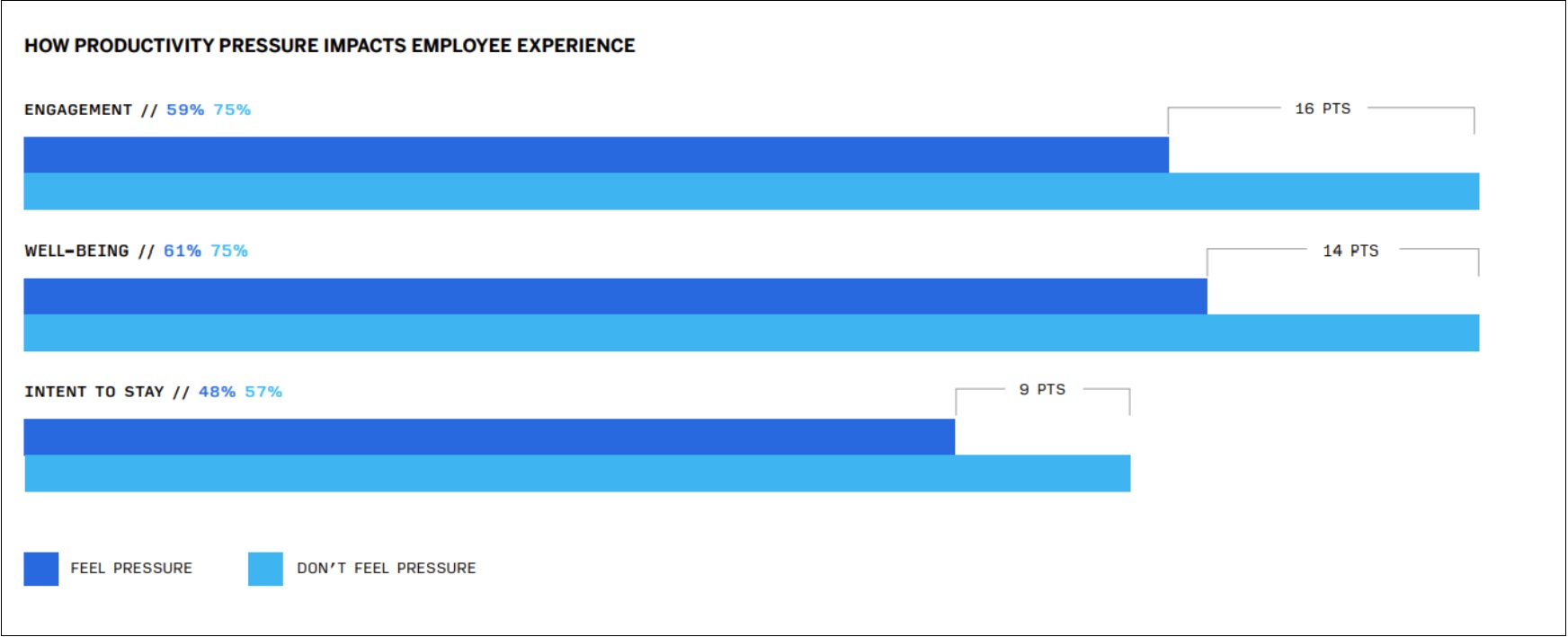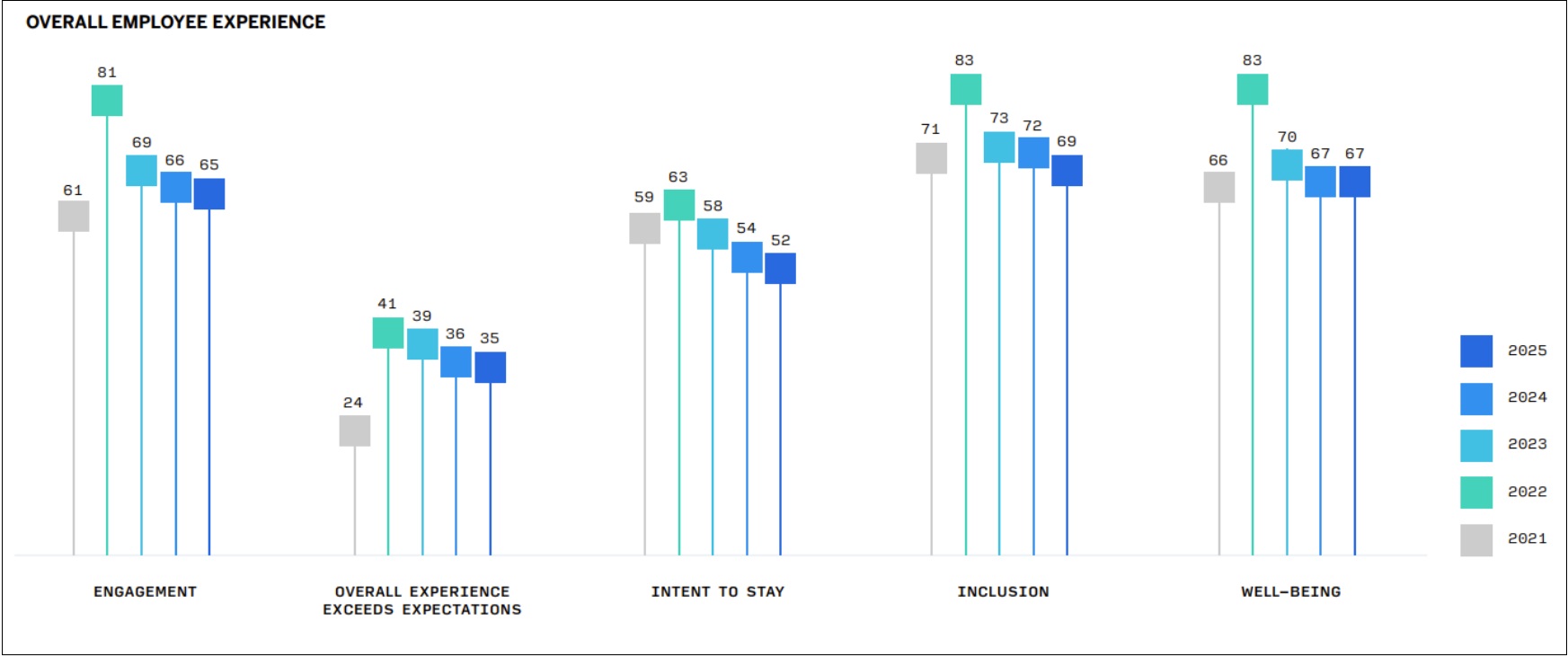Australian employees have ranked their employment experience among the world’s worst, according to new data released today.
Qualtrics’ 2025 Employee Experience Trends Report, which surveyed over 35,000 employees across 32 countries, found Aussie workplaces rank significantly behind the global average, often appearing among the bottom 20 per cent of nations.
Over 2,000 Australians rated their bosses lower on all five metrics of engagement, intent to stay, inclusion, wellbeing, and overall experience exceeding expectations, providing similar results year-on-year.
The report paints a bleak picture of Aussie workers as tired, overworked and under pressure to meet ever-increasing productivity targets and employers as out-of-touch with their employees’ expectations and needs.
“Work has somehow become even more chaotic since the pandemic as employers pursue short-term wins and try to adapt ways of working for modern realities,” said Dr Cecilia Herbert, principal behavioural scientist at Qualtrics.
The 132 IT workers bucked this trend to rank slightly above global averages for most metrics except intent to stay, which was 9 per cent lower at 55 per cent.
There’s still room for improvement in the sector, however, with engagement ranked just 73 per cent, inclusion 76 per cent, wellbeing 75 per cent, and experience vs expectations a paltry 49 per cent.
Working harder, not smarter
With the increasing pace of change, the evolving nature of work, the roll-back of flexible working and increased role expectations, Australian workers are feeling the strain.
“We're seeing 40 per cent of Australians — which is higher than the global average — saying they're feeling pressure from their employers to increase their productivity,” Herbert told Information Age.

Productivity pressure has a real impact on employee experience. Source: Qualtrics
Among employees, productivity pressure was linked to a 16 per cent decrease in engagement, a 14 per cent drop in wellbeing and a 9 per cent decline in intent to stay.
Herbert said employers looking to drive performance need to get back to basics and collaborate with employees to find ways to streamline their work.
“AI is coming up as a really beautiful and elegant way to accelerate a lot of this productivity.
“But let's not get lost too much in the other areas we could be looking at, which are our existing systems and processes, and helping employees move more smoothly through their daily work in a frictionless way so they can come in, do their jobs and do it well.”
She recommended employers look at both high-tech solutions, like AI tools, as well as low-tech improvements, which could be as simple as streamlining an inefficient invoicing process.
“Moving these obstacles is going to be the biggest productivity unlock for organisations.”
One foot out the door
Busting the myth of the ‘new starter glow’, employees who had been with their organisation for less than six months reported the worst experience overall.
Herbert said she was surprised to find this wasn’t connected to employee onboarding, which was largely seen as a good experience.
“It was actually the candidate experience before onboarding that was the least positive,” she shared.
This means many new employees in Australia are starting with “one foot out the door” and indicates workplaces could greatly benefit from improving their hiring practices.

Australian employee experience over the past five years. Source: Qualtrics
Exit experiences were rated just as poorly as candidate experience, which Herbert warned can negatively influence the employees who stay, as well as potentially damage your reputation and brand.
“We can tell you from this data it is very much impacting your existing employee experiences, and it's also going to be impacting the way people perceive their interactions with your organisation — even when they're not there anymore, they're probably customers,” she cautioned.
Quitting? Nah, mate
While Australian employees reported a far lower intent to stay than their overseas counterparts, Herbert said this isn’t necessarily a cause for concern.
“Currently, we’re about twelve points lower on employees’ intention to stay three or more years compared to the global average.
“However, if you actually look at the statistics, we’re not jumping around.”
Low intention to stay is in line with previous years' findings, she said, but isn’t reflected in ABS job mobility statistics, which show only 8 per cent of people changed roles in the past 12 months.
Herbert suggested Australians may simply be more conservative when it comes to predicting the future, preferring to adopt a ‘wait-and-see’ approach.
“Chances are they're taking it as it comes more than global employees,” she added.










